NAGYSAJÓ
Nagysajó (Gross-Schogen, Şieu) is located in the north-east corner of the Transylvanian Mezőség region, Bistrita-Nasaud county. The first written records indicate that presumably in this spot, there was a monastery in the XII th century.
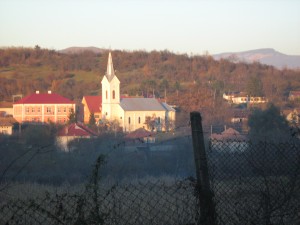
The old lutheran church, today ortodox church in Nagysajó
Today Nagysajó it is an extremely important settlement for two reasons: One is its history, which witnessed during the long centuries the cultural and social events of the hungarians in Transylvania. The other is the folk music, which is one of the outstanding values of the Transylvanian Mezőség.
Nagysajó first appears in 1228 as: caput (fluminis) Soyo, and then in 1319 mentioned in documents as Nogsoyou or Nogsayounak. In 1443 was written as Nagsayo, than in 1453 Sayo, Alsosayo.
The Parish church was built in 1332. The medieval Catholic believers in the reformation period in 1569 became of Lutheran religion and their church also. There was a time when the Lutherans also belonged under the protestant bishop. Unfortunately, out of the walls of the old medieval church now nothing remained but the actual hill-shape shows its former location.
The saxons of Nagysajó built from donations in 1900-1902 the actual church in the place where the medieval church was. The church with coffered ceiling was owned by the Lutheran Church until 1980, and than became the Orthodox Church. It’s interior was painted in 2005.
The Protestants have left the Lutheran community, and the’ve built their own churches.
Due to the fact, that the hungarian reformed community has increased as population, count Sámuel Kemény was asked to built a bigger church. At the request of the faithful, God's glory and joy of the Holy in 1783 a Reformed church was built in Nagysajó by Count Samuel Kemény. The Baroque building with its particularly valuable interiors was built out of brick and river stone. Beautiful carved benches are inside and the pulpit is made of stone.
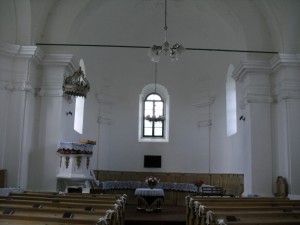
The interior of the old reformed chursh
Unfortunately, the devotional objects which were given for the church by Samuel Kemény were all lost in 1848.
The priest's estate was offered by baron Kemény Mikosné and count Krisztina Wass and the stone building was erected by counsellor Sámuel Kemény in 1812. The organ from the church was also donated in 1886 by a member of the Kemény family..
The Kemény family possessed Nagysajó and its area for several centuries.
Samuel Kemény was the most famous landlord in Nagysajó, who spent most of his time here. Being a royal chamberlain (Financial Secretary), has repeatedly made its way to Vienna from Nagysajó, with a 6 horse carriage. His coachman was the great-great grandfather of the retired veterinarian István Kertész from Nagysajó, who knows a lot about the count.
The Kemény family lived in a castle opposite the church, which currently operates as People's Council.
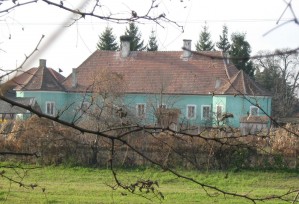
Sámuel Kemény's castle today
The castle was built in the XVIII century by the parents of Sámuel Kemény, count Kemény Miklós and his wife: count Wass Krisztina (Kemény Miklósné) who are buried in Nagysajó.
When this branch of the Kemény family died out, the castle became in the ownership of the Bánffy family, whose last owner was András Bánffy until he has lost the property on a card game around 1940.
A document indicates that this castle was built on the foundations of the Miklós Apafi’s mansion.
The other Kemény castle is currently functioning as a school. It is known as Kemény castle, but originally was the one floor castle of Maria Theresa. Legend says that a tunnel leads from the cellar of the castle until the Teleki Castle at paszmos and another tunnel goes to the eastern part of the chapel.
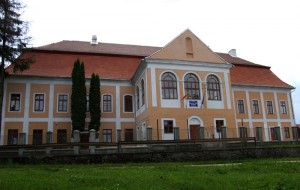
The hunting lodge of price János Kemény (today school)
Historical data says that the castle was built by the prince of Transylvania János Kemény in the XVII. century. The Kemény family owned for many years until it was nationalized. The prince used this castle as a hunting lodge.
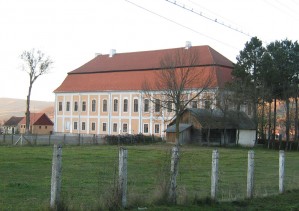
The hunting lodge of price János Kemény from the back
The famous writer László Gagyi was teaching in Nagysajó. From here he was called by Sándor Makkai to Kolozsvár/Cluj to the Reformed College. Later he became member of the writers group Erdélyi Helikon from Marosvécs.
We still have data of the Bánffy family, a branch of Losonczi, whose families were born in Nagysajó between 1396-1486. This family branch of the XVII. century, became extinct. In the east of the village there is a hill, a so called 'Kerekdomb', a round-hill with a borderline. Here stood the castle in the XI-XII century. During the Turkish occupation, the Turks have been used the castle cellar also. It is said that the cellar was so large that carts could go in. In the Hungarian period, around 1940-1944, a saxon peasant plowed the chimney of the cellar. After this case the Hungarian public administration intended to explore the place, but due to the war the research failed to start.
Also in the east of the village there is a chapel hill, between the village and the 'Kerekdomb'. Here was a burial place and a chapel. Here were buried members of the Kemény family. A superior surface shape, on top of which once the chapel stood. The chapel has led to the passage tombs built in semi-circle shape. At the time of an invasion the chapel was burnt down, and since than the tombs can not be accessed, the entrance is concealed.
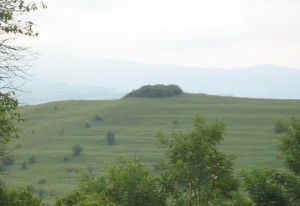
The burial place of the Kemény family
The danger has passed, the conceal remained, there is not anyone had been buried since the beginning of the 1800s. The last death of an aristocratic family, a certain named Igor, the burial had to take place in 1870, but all efforts failed. There was no other solution for the funeral than to lay Igor's coffin behind the chapel into the cone-like pile. It is said that in the 1930s the burial place was opened, and thus more people could see crypts constructed in a semi-circular shape. Samuel Kemény is certainly buried here. Prove this contention is that no one knows the burial place. According to sources, Samuel Kemény rests in eternal peace in a small village in Transylvania and his parents are buried here also.
If anyone has more information about the topics related to Nagysajó, than the ones written here, please let us know! This email address is being protected from spambots. You need JavaScript enabled to view it.
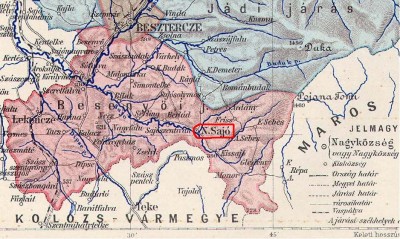
Nagysajó on the map


